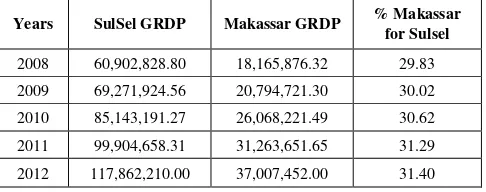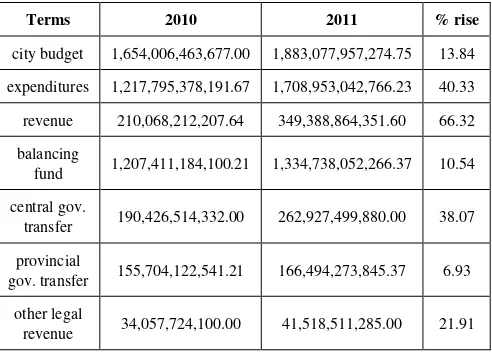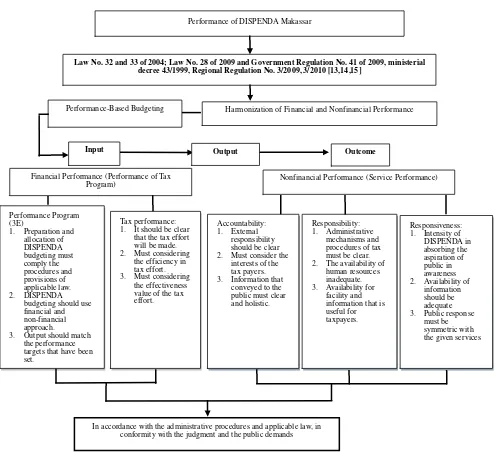The Performance of Revenue Office in the Perspective of
New Public Management - (Study on Performance of
Local Tax Management in Makassar, Indonesia)
Bambang Ibnu Marto1,*, Abdul Hakim2, Andy Fefta Wijaya2, Ruth Nur Pratiwi2
1
Doctoral Program of Administrative Studies, Faculty of Administrative Science, University of Brawijaya, Malang, Indonesia
2
Faculty of Administrative Science, University of Brawijaya, Malang, Indonesia
Abstract
Local taxes is a source of local revenue (PAD), which is managed directly by the Department of Revenue (DISPENDA) as a public organization. Measurement on the performance of public organizations conducted with financial approach (Value for Money) with indicator of Efficient, Effective and Economical (3E), the adoption of the New Public Management (NPM) concept practiced in public sector organizations. Otherwise, non financial approach was conducted with indicators of accountability, responsibility, and responsiveness; measuring the tax payer satisfaction. The results of the study used for the program performance of budget activity, indicating the financial performance of the Regional Revenue Office (DISPENDA) Makassar City Government of Indonesia, whether it has met the target and the corresponding measurement principle value for money. Temporarily, the performance of local taxes based on the indicators of tax effort, tax effectiveness and efficiency of tax showed the tax potential exploration area is not maximized, but achievement on the budget targets and the use of the program includes categories of effective and efficient. While the achievement of non-financial performance indicators showed impressed normative accountability, responsibility and responsiveness which normally runs pretty good.Keywords
Performance, Local Taxes, Local Government1. Introduction
Public sector organizations in the era of regional autonomy are a manifestation of the decentralization concept. Management urgently need a new government in accordance with the demands of times and society. Description above expectations, according Hughes [1] is the change of public bureaucracies through the approach of New Public Management (NPM) as a new paradigm in an effort to transform the rigid and hierarchical bureaucratic form of public administration, into a flexible and market-oriented bureaucracy for service users/subscribers of public management.
Furthermore, Osborne and Gaebler [2] stated people requires a bureaucracy that "Good Governance and entrepreneurial Government", courage competition, accountability, responsive to change, transparent, stick to the rules, the participation of service users, concerned with quality, effective and efficient, as well as justice. Existence of Regional Revenue Office (DISPENDA) as a driver of
* Corresponding author:
[email protected] (Bambang Ibnu Marto) Published online at http://journal.sapub.org/ijas
Copyright © 2015 Scientific & Academic Publishing. All Rights Reserved
development in the performance for their accountability area is necessary because it deals directly with the problem of local finance. Kaho [3] suggests that the regional government will not be able to carry out its functions efficiently and effectively without consider the cost to provide services and development. Associated with the phenomenon of local financial management, Government of Makassar, Indonesia presents the description of the GDP value in 2008-2012 (Table 1).
Table 1. Basic Price of Gross Regional Domestic Product (GRDP) of South Sulawesi (SulSel) and Makassar of 2008-2012(in Rupiah)
Years SulSel GRDP Makassar GRDP % Makassar for Sulsel
2008 60,902,828.80 18,165,876.32 29.83 2009 69,271,924.56 20,794,721.30 30.02 2010 85,143,191.27 26,068,221.49 30.62 2011 99,904,658.31 31,263,651.65 31.29 2012 117,862,210.00 37,007,452.00 31.40
Source: Central Bureau of Statistics in Makassar [4].
water supply; construction; trade, restaurants and hotels; transportation and communication; finance, leasing and business services; and services [4].
This condition would correlate with local revenue (PAD), particularly from the aspect of local tax revenue. While local taxes have an important role in the implementation of financial management areas, where the local tax system has a broad impact on (1) the capabilities and business activities of the taxpayer; (2) the regional administration; and (3) macroeconomic developments [5].
Based on the above description, it is increasingly realized the need for Local Government to apply the concept of performance-based budgeting in each organizational unit (SKPD), especially at the Department of Revenue as a public organization that is directly in contact with local revenue. In regard to the achievement of targets and realization of management of local taxes?
2. How do non-financial performance of the Regional Revenue Office (DISPENDA) of Makassar in the management of local taxes?
3. What are the factors that support and hinder the financial and non-financial performance of the Regional Revenue Office (DISPENDA) of Makassar in the management of local taxes?
4. How is the performance model of the Regional Sulawesi traffic intersection. This city is geographically a flat coastal area with slopes of 0-5° to the west with an area of 175.77 km2. As the provincial capital of South Sulawesi, Makassar is the gateway to Eastern Indonesia.
Revenue Service of Makassar as stated in Article 124 in Law No. 32 of 2004 on Local Government, are implementing elements of local autonomy. In this case, Revenue Service of Makassar is the Local Government Unit (SKPD) as the responsibility centre for its entity. The existence of Makassar Revenue Service is a non profit and the complementary part in assisting the tasks implementation of the Makassar Government.
With the vision of providing the largest contribution to revenue receipts and the mission plan revenue (PAD) and PAD polling intensification plan as well as fostering the implementation of working procedures and organizational structure with other fields. Revenue goal is to provide public awareness and taxpayers to avoid late fees are required to
meet its obligations and to seek the achievement of the original income [6].
Table 2. Makassar Financial of 2010-2011 (in Rupiah)
Terms 2010 2011 % rise
city budget 1,654,006,463,677.00 1,883,077,957,274.75 13.84
expenditures 1,217,795,378,191.67 1,708,953,042,766.23 40.33
revenue 210,068,212,207.64 349,388,864,351.60 66.32
balancing
fund 1,207,411,184,100.21 1,334,738,052,266.37 10.54
central gov.
transfer 190,426,514,332.00 262,927,499,880.00 38.07
provincial
gov. transfer 155,704,122,541.21 166,494,273,845.37 6.93
other legal
revenue 34,057,724,100.00 41,518,511,285.00 21.91
2.2. The Research Approach
This study used qualitative research [7] as a study to observe a particular phenomenon or in depth problem in the context of a particular environment. The phenomenon in question is "Performance of Regional Revenue Office in the Perspective of New Public Management in Local Taxes
Makassar, Indonesia”.
2.3. Research Focus
2.3.1. Financial Performance
Assessment on financial performance of Regional Revenue Office Makassar conducted on the utilization of operational budget allocation program for the activities. It focused on the goals and objectives of the program to improve the efficiency, the effectiveness of the organization in delivering public services. To determine the economic level, efficiency and effectiveness on the financial performance of program activities through the concept of
value for money approach, towards:
a) Actual cost for the activities program of Regional Revenue Office (DISPENDA) Makassar between the ratio of revenue and cost realization per program b) Local Taxes performance using several indicators, i.e.
Tax Effort; Tax Effectiveness; Tax Efficiency.
2.3.2. Non-Financial Performance
Tax administration consists of Main Tasks and Functions (Institution), Human Resources (Person) and Collection Activities, covers: (a). Registration and data collection, (b). Determination, (c). Accounting and Reporting, (d). Billing. It also considers the aspect of accountability, responsibility and responsiveness.
2.3.3. Affecting Factors
include: Internal factors and External factors [8].
2.4. Data Processing
Data were collected by observation, interview and documentation. After performed data collection, we conducted data reduction. It is defined as the process of selecting, sorting, simplifying and transformation of rough data. Data display rendering over activity of information that has been compiled. We setup the data systematically with the order of focus and the sub-focus; simplify the researcher to analyse it. It also provided interpretations of the conclusion drawing or verifying. In sum, the activities are interpretation, subjective meaning on a phenomenon, and composing the interrelations between events, comparing, contrasting, and linking up the various events related to the object [9].
3. Result and Discussion
3.1. Financial Performance of DISPENDA Makassar towards Local Tax Management
3.1.1. Measurement of Financial Performance of DISPENDA Makassar towards Local Tax Management
Findings: Performance on Program of 2009-2012
budgets shows that:
1) Assessment on economy ratio is pretty good, with average ratio of overall economic activity program for 91.17%, include in the economical category. Regional DISPENDA Makassar in operating their expenses is categorized as spending less.
2) Assessment on efficiency ratio for the financial performance is pretty good; average efficiency ratio of 19.42% with the rating efficient category. DISPENDA Makassar categorized spending less in operating their expenses for program activities.
3) Assessment on the effectiveness ratio indicates good financial performance, where the average effectiveness ratio of 104.22% with the rating category of very effective. DISPENDA Makassar including spending wisely in their expenses [10].
3.1.2. Measurement on Performance of Local Tax Revenue Office Makassar towards Local Tax Management
Findings: Tax Performance with three main indicators: 1) Tax Effort; showed no significant effect of changes on
Gross Regional Domestic Product (GRDP) to increase local tax revenue.
2) Tax Effectiveness; showed average performance index of 1.04 is relatively stable during the fiscal year 2009- 2012.
3) Tax Efficiency; showed the value of Cost of Collection Efficiency Ratio (CCER) for fiscal years of 2009-2012 ranged 14.33 – 22.02% with an average of 17.65% (Rp.30,569,442,854.00) the realization of the actual
cost of local tax revenue by Rp. 225,821,665,043.00. Highest CCER found in 2012 for 14.22%, while the lowest occurred in 2010 for 22.02%. The low achievement of CCER due to the level of effectiveness (TPI) does not reach the target, especially for the reliable taxes. Thus, CCER achievement with an average rate of 17.65% showed financial performance in cost efficiency included in pretty good. Findings in this study indicate that DISPENDA Makassar has run their duties and functions well in the optimization of available resources [10].
3.2. Non-financial Performance of DISPENDA Makassar towards Local Tax Management
3.2.1. Implementation of Regional Tax Administration of DISPENDA Makassar towards Local Tax
Management
Findings: Performance of Tax Administration 1) Main Tasks and Functions (Institution);
There is already a description for each task in detail areas and section. Yet it has not shown the existence of poverty and capacity on activities or tasks formulation that provide guidance in the implementation of the activities in sequences or respectively, the authority or scope of tasks, coordination, and required equipments.
The lack of counselling unit/section; even this unit is strategic to means socialization related to the regional tax to support the functions performed by other units. It also has lack of coordination between the sections and it should harmonize the policies.
2) Human Resources (Person);
Implementation of registration and data collection has been running optimally, but needs to be sustainable in achieving the targets. The lack of coordination with other agencies causes by the lack of personnel, inadequate
personnel’s quality, lack of new taxpayer data, and less
supporting facilities. The activity of determination was not running optimally. Otherwise, the activity of accounting, reporting, and records collection/payment/remittance of local taxes has been run as administrative mechanisms.
3.2.2. Measurement on Non-financial Performance of DISPENDA towards Regional Tax Management: Aspect of Accountability, Responsibility, and Responsiveness
developing norms in society. Second, responsibility is a measure that indicates the process of providing public services. It must be carried out according to the principles or provisions of administrative and organization. Last, responsiveness of the service providers should complying the expectations and demands of users (public interest).
Accountability
The performance indicates that accountability of DISPENDA Makassar bureaucratic is still relatively low. The low performance of accountability was due to the unavailable media on accountability information of the DISPENDA Makassar in the management of local taxes.
Responsibility
Responsibility has been running as it supposed to be. The implementation of the programs and activities in DISPENDA Makassar has been carried out in accordance with the principles of proper administration and in accordance with organizational policies.
Responsiveness
DISPENDA Makassar shows good responsiveness. They can recognize the wishes, needs, and demands of tax payers. I can be interpreted that DISPENDA Makassar was successfully implement the programs and activities to realize the vision, mission and goals of the organization, especially to fulfil the needs of taxpayer as in the policy strategy.
3.3. Supporting and Inhibiting Factors
3.3.1. Internal Factors development program of management activities, especially management of local revenue of 2009-2014 period
- Standard Operational Procedures (SOP) to guide principal activities of local tax administration
- Availability of infrastructure and the unit leader’s
commitment.
Inhibiting factors
- Professionalism apparatus is relatively low
- Process of monitoring and evaluation; management of local taxes is less efficient
- Internal Control of DISPENDA and coordination with related agencies are still low
- Utilization of information technology, e.g. blog/web
3.3.2. External factors
Supporting factors
- Regulation; strengthen the legal basis for the collection and retribution of local taxes
- Regional Regulation of Makassar City No. 3 of 2010 on
Local Taxes of Makassar
- Local tax resources from the service sector - Administration SOP of local taxes
Inhibiting factors
- Regulation related to local taxes
- Monthly fluctuations in local tax revenue - Regional and international issues
- Complexity of licensing investment in Makassar [12]
4. Conclusions
Financial perspective for the category of Program Performance and Tax Performance as follows:
1) Program Performance category; have reflected a comparison mechanism between inputs and outputs in the process and outcomes of the programs and activities implementation that are economical, efficient and effective (3E)
2) Tax Performance category; "Good enough" in an effort to use the budget at low cost (spending well) 3) Service Performance category; relatively low
accountability, responsibility has been running as it should and pretty good responsiveness
5. Recommendations
Based on the findings and analysis of DISPENDA Makassar, we offer a recommendation model as Figure 1. To measure the performance of the organization in the future, we suggest to not using comparison between the target and the realization of the tax, but using the comparison of potential tax with the realization of tax. Data comparing of the potential and realization tax could be used to plan future strategy. It will explain the weaknesses and specifies the factors that affect the performance of the organization refer to the plan. On the tax gap, in addition to describing the potential non-filing tax, under-reporting and under-payment, this research suggest to add another variable, i.e. invisible potential that is useful to explain the potential hidden and unexplored tax.
To cope the high cost of taxation, the government need to formulate administration policies of taxation reform by reducing the cost of the collection (tax operating cost), facilitate charging office, and estimate the true tax potential (presumptive taxation). Improvement of tax administration should also be conducted on a group of taxpayers and groups at the center power of taxation facility.
Figure 1. Recommendation of Performance Model for DISPENDA towards Local Taxes Management
References to the taxpayer – in the context of tax efficiency suggest by pressing tax compliance especially on time cost and psychology per type of tax cost on local taxes. Taxpayers can prepare tax reporting system by utilizing electronic files (email) to reduce the cost of the document, the cost of transportation and document storage costs.
REFERENCES
[1] Hughes, O.E., 1998. Public Management and Administration. 2nd Ed, London Mac Millan Press Ltd, p. 41.
[2] Osborne, D. & Gaebler, T., 1992. Reinventing Government How the Entrepreneurial Spirit is transforming the Public Sector, Pustaka Buana Press.
[3] Kaho, J. R., 1997, Prospects of Regional Autonomy in the Republic of Indonesia: Identify several factors that affect the implementation): First Edition, Fourth Printing, Eagle Press, Jakarta, p. 125.
[4] Central Bureau of Statistics Makassar, 2012, Gross Regional Domestic Product (GRDP) of South Sulawesi (SulSel) and Makassar of 2008-2012. Makassar.
[5] Nick, D., 1989, Financial of Regional Government in Indonesia, Maris, M., Transl., UI Press, Jakarta.
[6] Government of Makassar, 2012, Makassar in Numbers of 2012, Government of Makassar.
[7] Miles, M. B., & Huberman, A. M., 1992, Qualitative data analysis: references on new methods, Rohidi, T. R., Transl., University of Indonesia Press, Jakarta.
[8] Davis, O. A., & Larkey, P. D., 1980, Measuring the efficiency and effectiveness of government activities, from improving
Responsiveness:
Performance of DISPENDA Makassar
Financial Performance (Performance of Tax
Program) Nonfinancial Performance (Service Performance)
Tax performance:
Harmonization of Financial and Nonfinancial Performance
Output Outcome
Input
Performance-Based Budgeting
Law No. 32 and 33 of 2004; Law No. 28 of 2009 and Government Regulation No. 41 of 2009, ministerial decree 43/1999, Regional Regulation No. 3/2009, 3/2010 [13,14,15]
the financial discipline of State and Cities, Solomons D. Ed., [9] Mardiasmo, 2002, Accounting in public sector, Andi
Publisher, Yogyakarta.
[10] Mahsun, M., 2006. Performance assessment of public sector, BPFE-Yogyakarta.
[11] Lenvine, CH., B.G. & F. J. Thomson, 1990, Public administration: challenges, choice, consequences. Glenview Illinois: Scott, Foreman/Little Brown Higher Education, p. 188.
[12] Prahalad C.K., & Gary Hamel, 1990, The core competence of the corporation, Harvard Business Review.
[13] Regional Regulation No. 6 of 2009, on the Medium term regional development planning (RPJMD) of Makassar 2009-2014.
[14] Regional Regulation No. 3 of 2009, on the formation and struktur of regional organization in Makassar.


